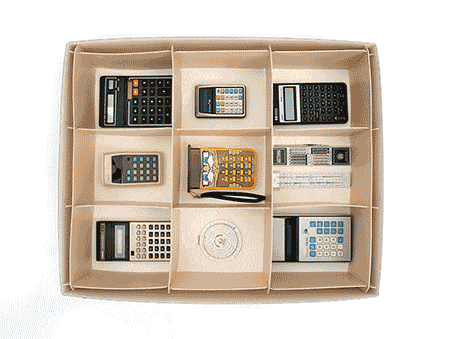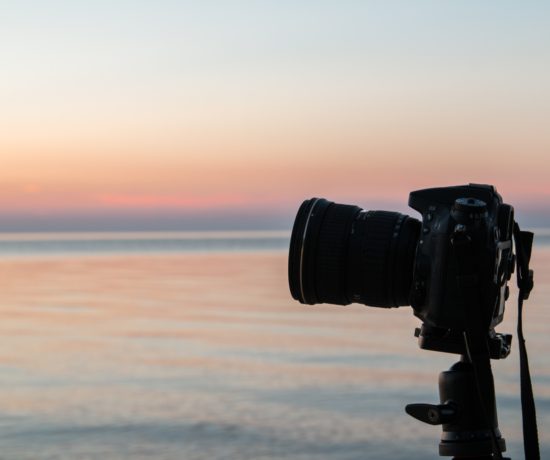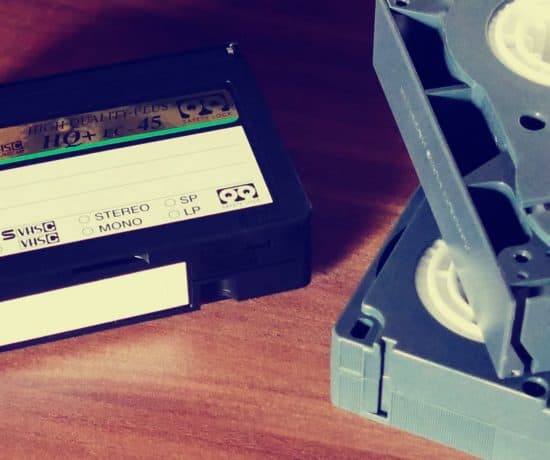Today we have a real treat for you! Our good friend and colleague, Kate Jacus (The Photo Curator), is here to outline the top 10 archival products to help you keep your family photos safe. Kate is a top specialist in archival storage, and works for both Archival Methods (our favorite archival products company) and The Photo Managers, so she knows a thing or two about this. Please enjoy her recommendations, and click the links for more detailed purchase info!
Top 10 Archival Storage Products
If you’re working on a large project like organizing and digitizing a family photo collection, you likely already have some photo boxes for your prints. However, there are a lot of other archival products that can be useful throughout your project as well!
(Sneaking in a bonus tip: during the sorting phase, use whatever boxes you have on hand. No need for archival storage boxes until you’ve decided what prints to keep and have scanned them.)
All of these products (or variations of them) can be purchased at Archival Methods or other reputable archival suppliers. Archival Methods is based in Rochester, NY and all of our boxes, binders, and portfolios are handcrafted at our facility there. We are a long-time partner of The Photo Managers and we love working with family memory keepers!
Check out our online Family History Preservation Guide, blog with preservation tips and resources, or contact us with questions about your photo storage projects.
Let’s look beyond the box at my top 10 favorites – in no particular order!
1. Polyethylene bags
Polyethylene is one of the three types of archival plastics. These bags won’t yellow or get brittle over time and are safe for long-term storage. They are fairly inexpensive and I like to have several sizes on hand. They are open-top, so don’t seal; you want airflow around what you’re storing so that mold-inducing microclimates don’t form.
Use polyethylene bags for isolating fragile or damaged photos or those with some adhesive residue on them. I also use bags to enclose vintage photo albums and scrapbooks before placing them into a storage box – the bag helps keep all the pieces together. Store newspapers and clippings in them so the newsprint doesn’t leach its acid onto other materials.
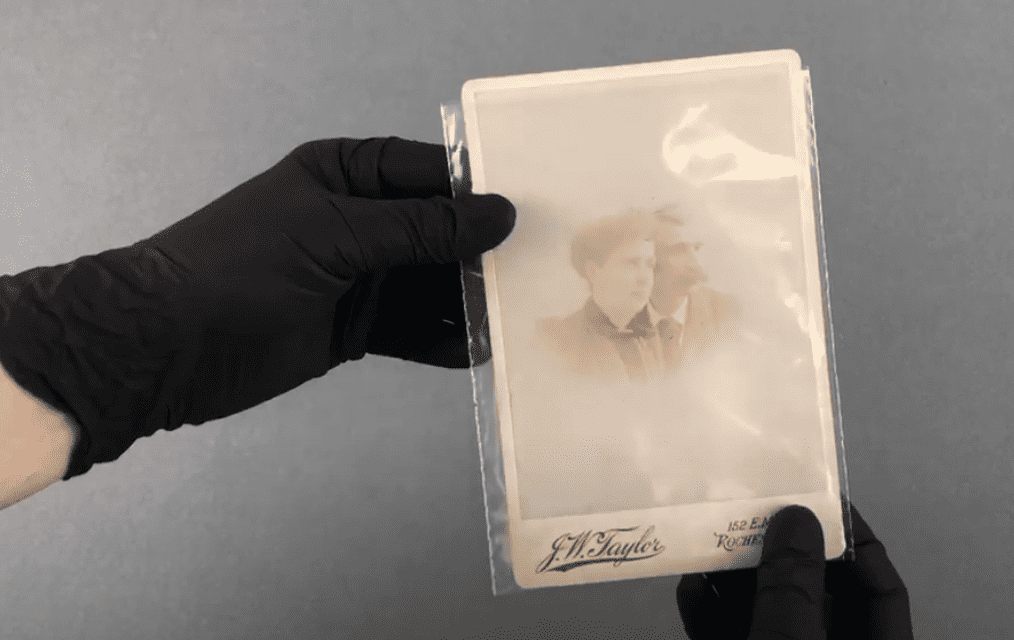
Polyethylene bags are great for keeping track of smaller photos stored alongside bigger ones!
More Info on this Archival Item + Purchase: Archival Methods polyethylene bags
2. Side-Loading Print Sleeves
Sometimes you have a fragile or damaged print that requires a bit more protection than a polyethylene bag provides. Polyester (another type of archival plastic) sleeves provide a stiffer enclosure. The side opening lets you easily slide in a photo without causing more damage and the flap edge holds it in securely.
Inserting a piece of acid-free cardstock cut to size provides even more stability. No need to adhere the photo to this backing since the sleeves will hold it in place. Now you’re handling the cardstock edges and not touching the photo at all – a best-case scenario. The reverse of the cardstock insert also makes a great place to write a caption.
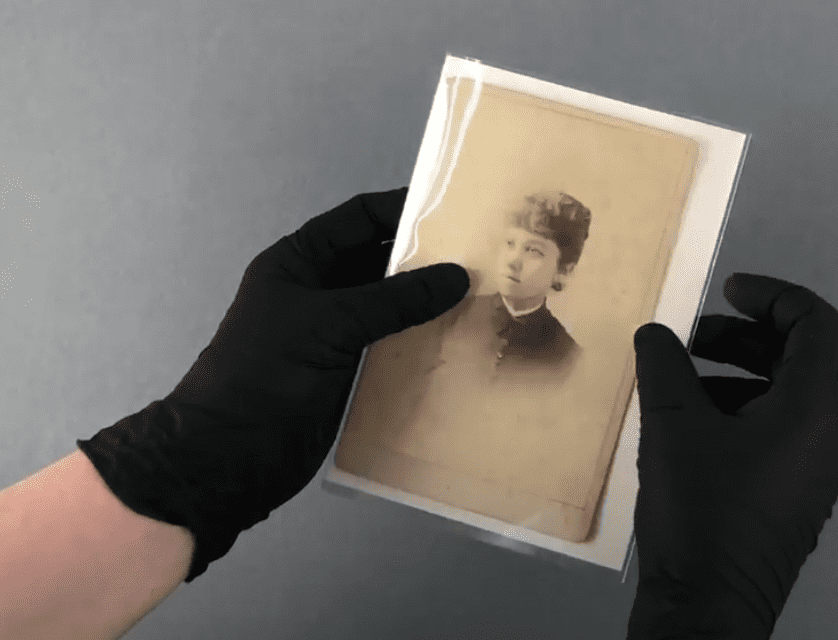
Acid-free cardstock can provide more support for fragile photos when combined with polyethylene bags.
More Info on this Archival Item + Purchase: Archival Methods side-loading print sleeves
3. Archival Tissue
Acid-free, buffered tissue has so many uses for archival storage! I like to keep packages of two different size sheets on hand. 8.5” x 11” sheets can be used to interleave vintage albums or scrapbooks where you want to protect the photos or memorabilia from the opposite page. You can also interleave stacks of photos that are laying flat in boxes, especially separating different types of prints.
Larger sheets like 20” x 24” are useful for wrapping textiles and other three-dimensional objects before storing them in an archival box. You’ll also want to take up space in these boxes, and crumpled archival tissue is a great way to do it.
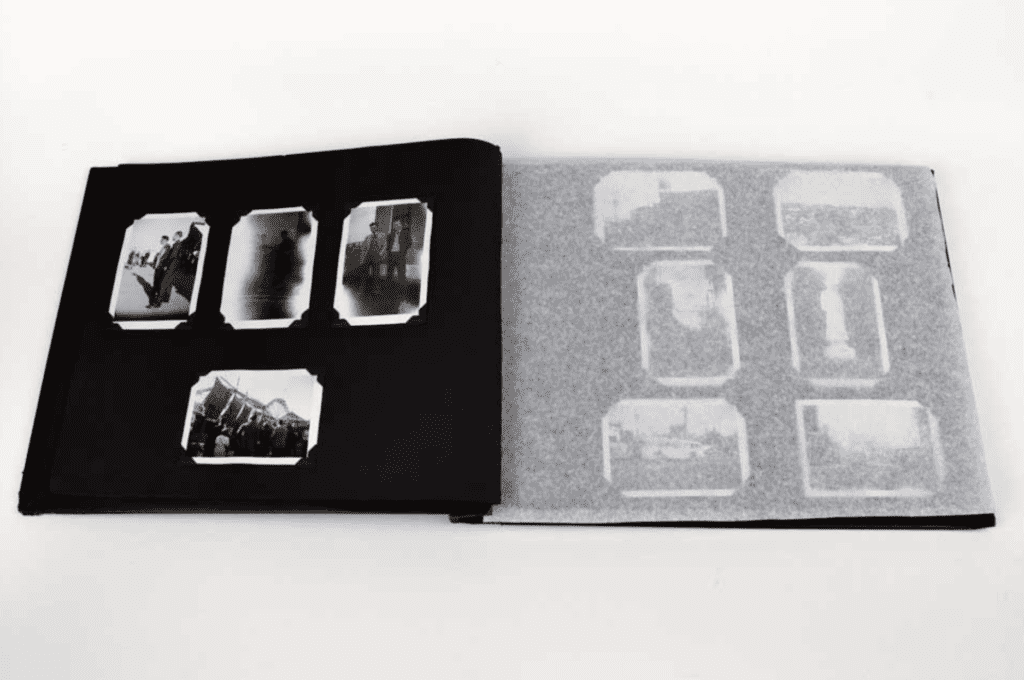
Archival tissue is great for preventing pages sticking together.
More Info on this Archival Item + Purchase: Archival Methods archival tissue
4. Stabilo-All Pencils
Connecting photographs with identifying information is an important part of your photo work. If you’re capturing that on the printed photos themselves, it’s best practice to use only pencil, never ink (even archival ink). Stabilo-All pencils are water-soluble and can be wiped off smooth surfaces with a damp cloth, or erased easily from paper.
They are excellent for writing on the backs of plastic-coated photographs and other glossy surfaces such as film, glass, plastic, and metal. And they work equally well on paper photos, album pages, and mounted photos.
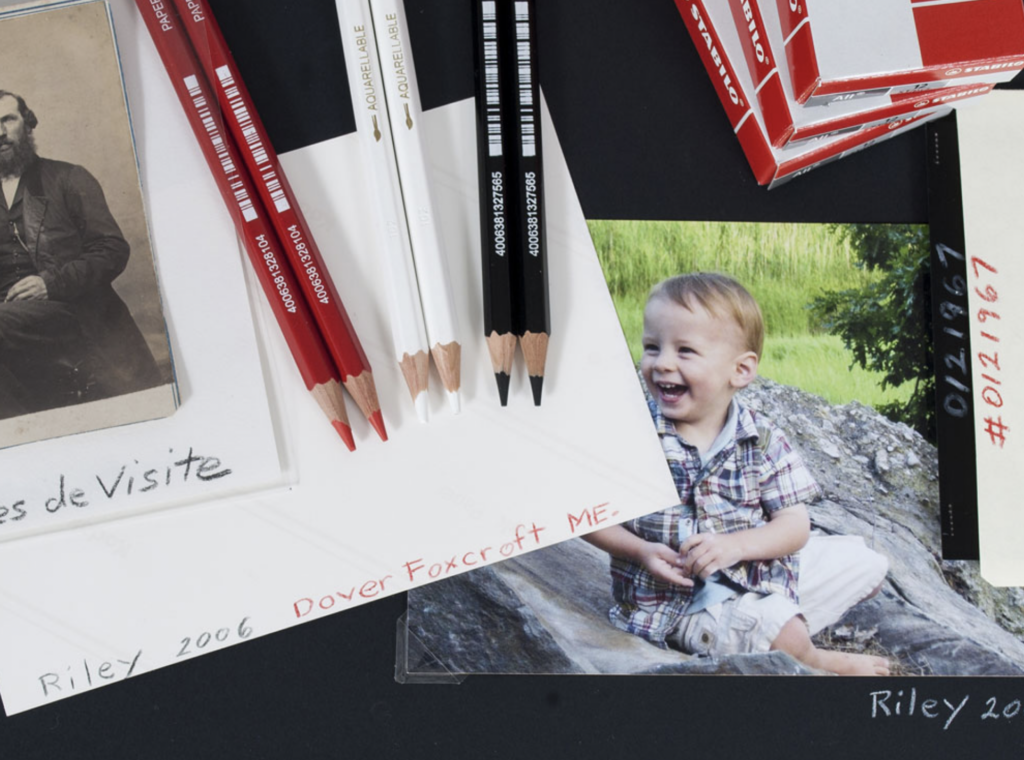
Stabilo pencils are great for writing on the backs of photos!
More Info on this Archival Item + Purchase: Archival Methods Stabilo-All Pencils
5. Drop Front Boxes
OK, I know this is a box, but it’s got an archival feature that makes it different than your average photo box. It has one side that is not connected to the others and folds down – a “drop front.” This improves access for the contents by allowing you to lift a stack from the bottom or easily sift through to find what you need – rather than jamming your fingers down the sides, potentially damaging what you have stored. Having that open side is the safest way to insert and remove items from a box.
Drop front boxes are great for larger prints that don’t fit in the regular 4×6 photo boxes. I’d also use these to stack fragile or damaged vintage photos (after I enclosed them in a polyethylene bag or sleeve, or interleaved with archival tissue). Be sure to not stack the photos so high that you have to compress them to put the lid on.
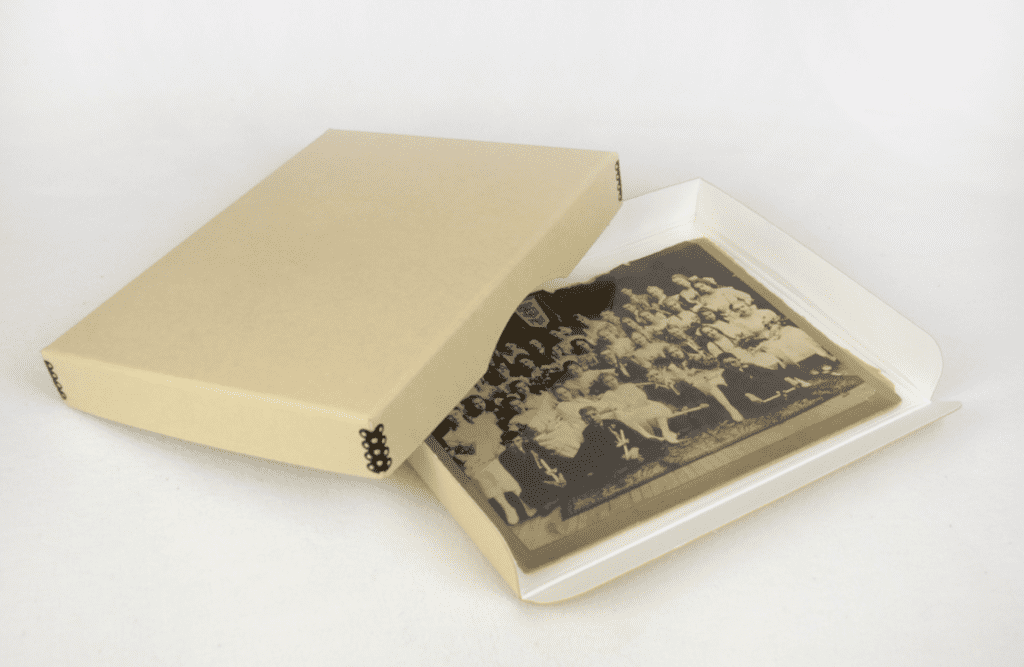
The drop front lets you stack boxes while still having access to the contents.
Bonus tip: the metal edges on these boxes give them extra rigidity so you can stack a few without worrying that they will collapse under some weight.
More Info on this Archival Item + Purchase: Archival Methods drop front boxes
6. Nitrile Gloves
A staple in the museum world, it’s worth bringing this practice to your project. Gloves should be worn when handling photographs because they are especially susceptible to damage from oils and perspiration from your hands. Many pros prefer nitrile gloves over cotton since they provide a stronger barrier against unknown or harmful substances, won’t snag, and allow for better dexterity. Look for powder-free nitrile gloves.
Bonus tip for the non-photo items in your collection: while gloves are recommended for handling paintings and leather or metal objects; clean bare hands are fine for paper, books, glass, china, ceramics, and most textiles.
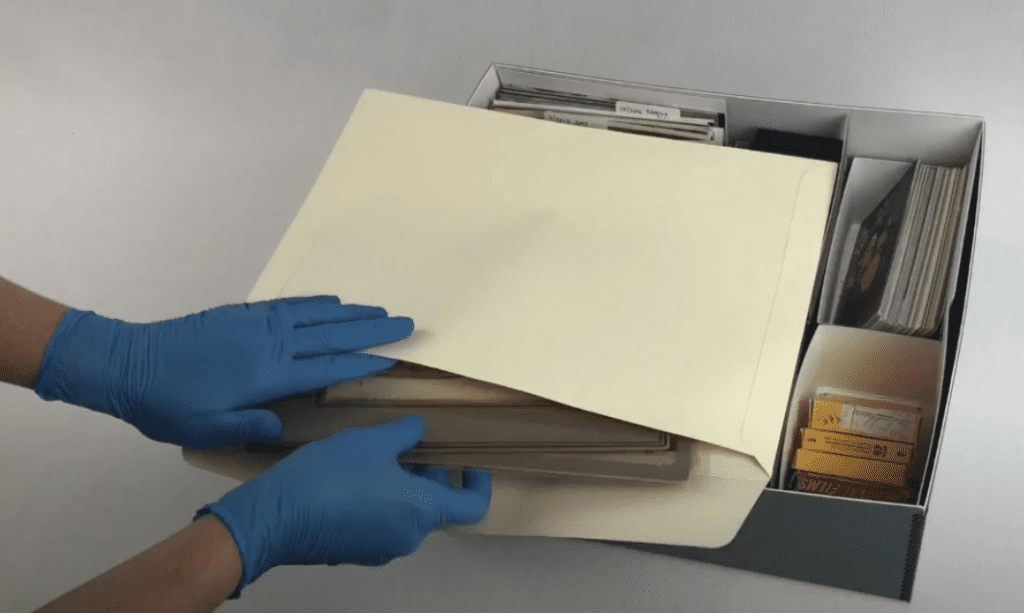
Most pros prefer using powder-free nitrile gloves since they don’t snag as easily and give you a better grip!
Purchase at home/hardware stores or on Amazon.
7. PEC-12 Cleaner
In any large photo collection, you’re going to come across photos that have stuff on them: adhesive residue, stray writing, tape still attached, etc. There is a cleaner that can help remove these. PEC-12 is a waterless photographic emulsion cleaner, designed to remove non-water-based stains, grease, and inks from photographic emulsions (photos, slides, film, and negatives). It removes finger oils, grease pencil, adhesive tape residues, mildew, smoke and soot damage, gold foil stamp, and most ball-point and permanent inks. And, it will aid in the removal of firmly affixed adhesive tape.
PEC-12 can also be used to clean scanner glass and camera lenses. You’ll want to use it in a well-ventilated area since it has a strong chemical odor.
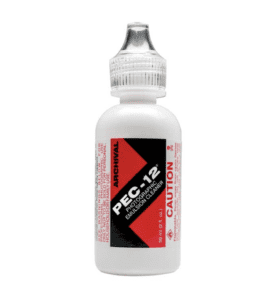
Bonus tip: if you have a particularly valuable photo that requires cleaning, it may be best to seek professional assistance. Check out the “Find a Conservator” search tool on the American Institute for Conservation website and look for someone who deals with photographs.
More Info on this Archival Item + Purchase: Archival Methods PEC-12 solution and pads
8. Binder-in-Box
Another box! But this one is also unique and more than just a photo box. For photos you want to keep more accessible, and not just stored away on a high shelf, the Binder-in-Box™ is a great option. It combines the protection of a metal-edged box with the utility and convenience of a binder. The enclosed box provides greater protection from light and dust than a standard 3-ring binder.
Special vintage photos or prints from a particular event can be safely stored but available to flip through and enjoy more regularly. Archival plastic photo pages come in various configurations to hold 3-1/2×5, 4×6, 5×7, or 8-1/2×11 prints. Additional sizes, including pages for slides, are available.
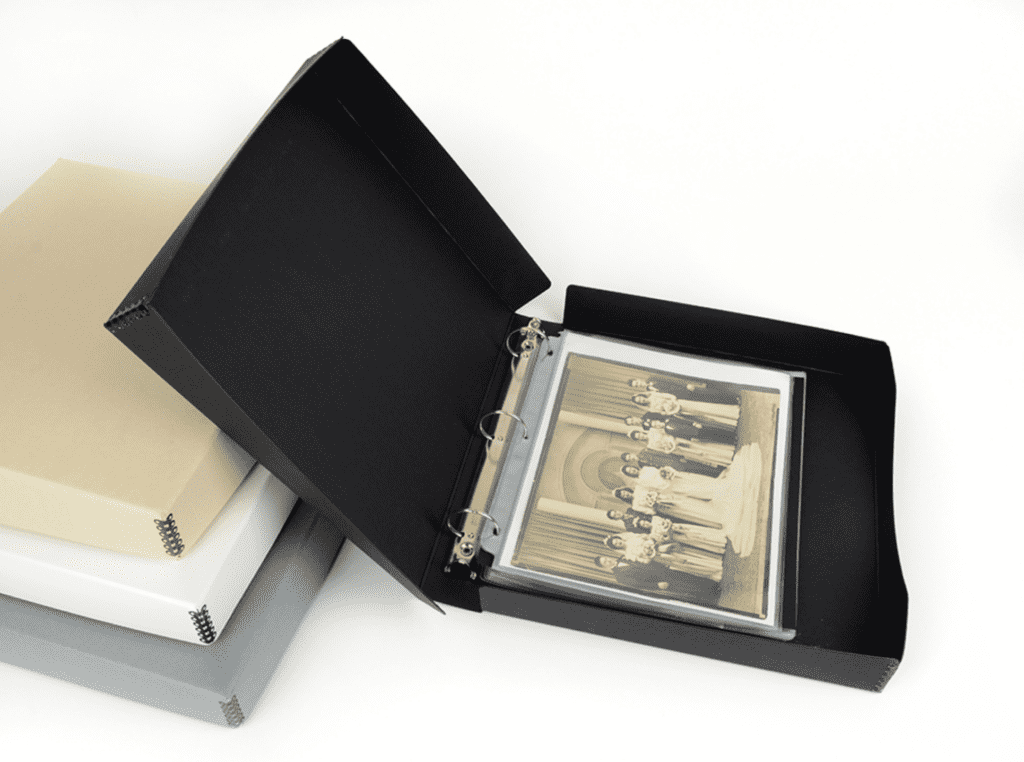
Want to browse your heritage photos more often, while still keeping them safe? Consider using this solution!
More Info on this Archival Item + Purchase: Archival Methods Binder-in-Box™ and photo pages
9. Adhesive Back Vinyl Labels
Labeling your photo storage is a critical part of the process. The better the label, the less a box and its contents need to be disturbed to see what’s inside. For a neater look, don’t write directly on the box. Using an adhesive-backed vinyl label holder, you’ll be able to insert a label and easily change it when needed.
Usually, the word “vinyl” connotes an archival red flag. While vinyl (also known as PVA or PVC) is not recommended for actual storage, its use as an exterior label holder on boxes and binders is perfectly acceptable.
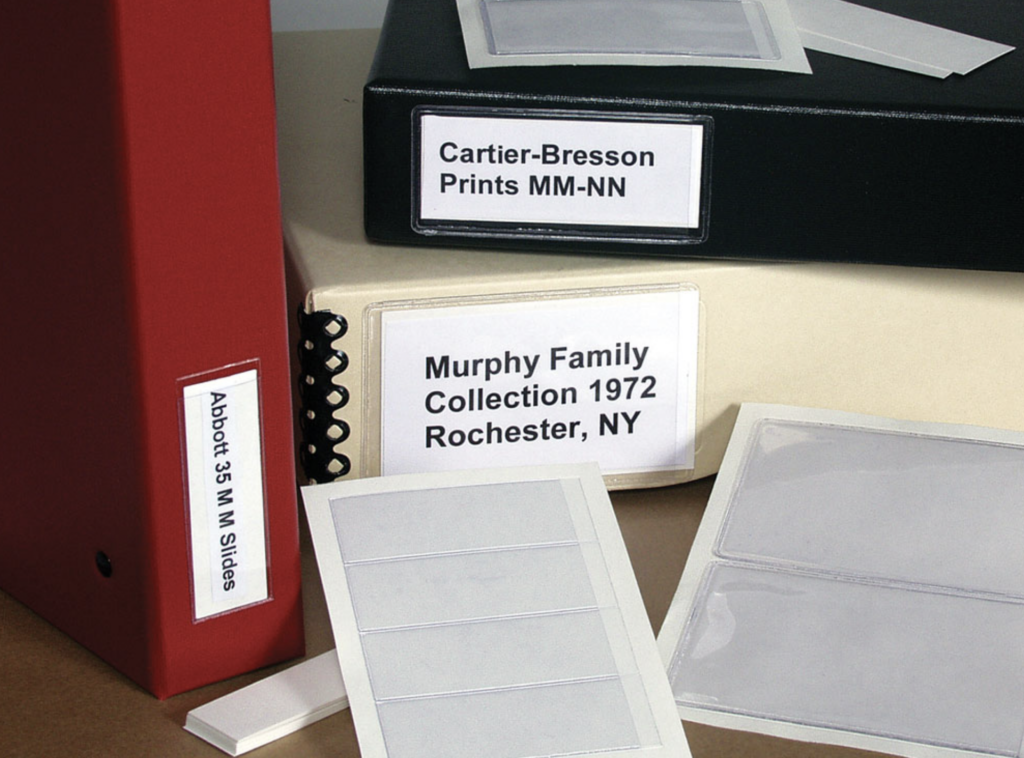
Labeling is key to any organizing project!
Bonus tip: These have lots of other uses! Put them on your external hard drives and insert a note about the purchase and replace dates. Label household or office storage bins, drawers, etc. – anywhere you want to be able to change the label when necessary.
More Info on this Archival Item + Purchase: Archival Methods adhesive back vinyl labels
10. Object Storage Kits
I’m sharing one more box, and it’s not even for photos! Inevitably you’ll come across collections of objects as you sort through family heirlooms. Give these treasures a safe home in an object storage box. The dividers (we make them in 9 and 16 compartments) help organize and protect the objects.
Wrap items in archival tissue or use polyethylene bags to sort smaller items. Pad the compartments with crumpled tissue to keep things from sliding around. As with photo boxes, don’t forget to label the outside, or, even better, slip an inventory list just inside the box.
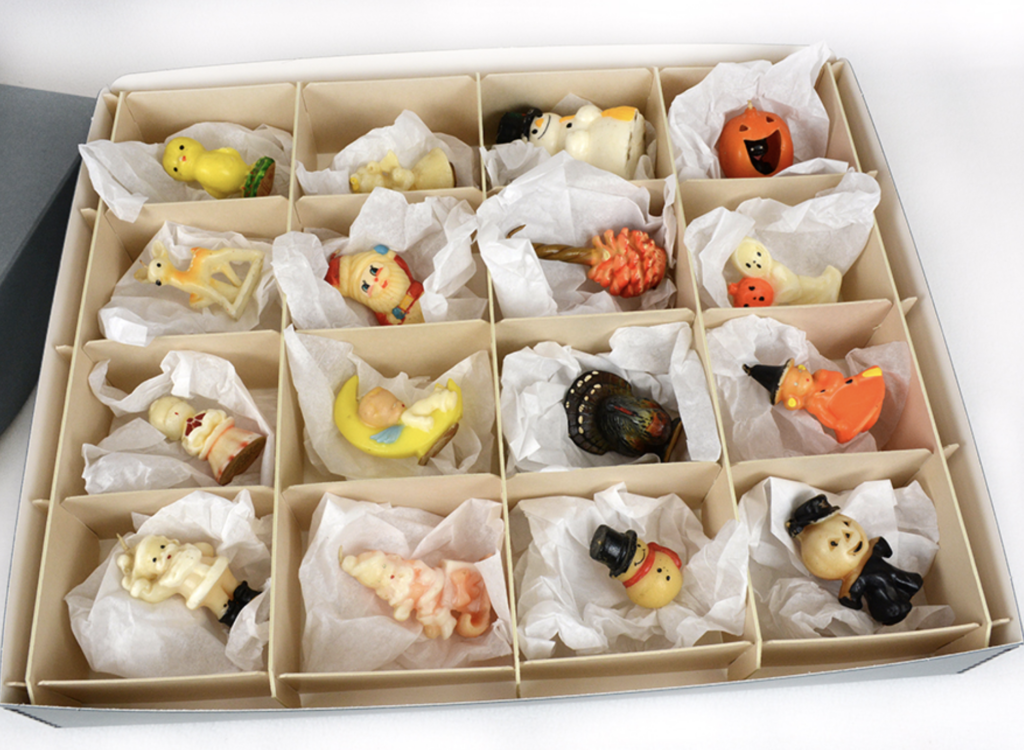
Got smaller stuff to store? Consider an object kit!
Bonus tip: The Archival Methods compartment dividers can be ordered separately and can be trimmed and customized to fit dresser drawers and other boxes.
More Info on this Archival Item + Purchase: Archival Methods object storage kits
What do you think?
Will you be using some of these archival photo storage items for your collection?
Let us know in the comments below!
[Editor’s Note: Thanks Kate for all of these great recommendations! For anyone considering archival storage, we couldn’t agree more with these recommendations! These products are all worth investing in – great solutions, great quality, and Archival Methods has great customer service! If you’d like to read up more on what the term archival really means, check out this article right here!]
All Photos Courtesy of Archival Methods

